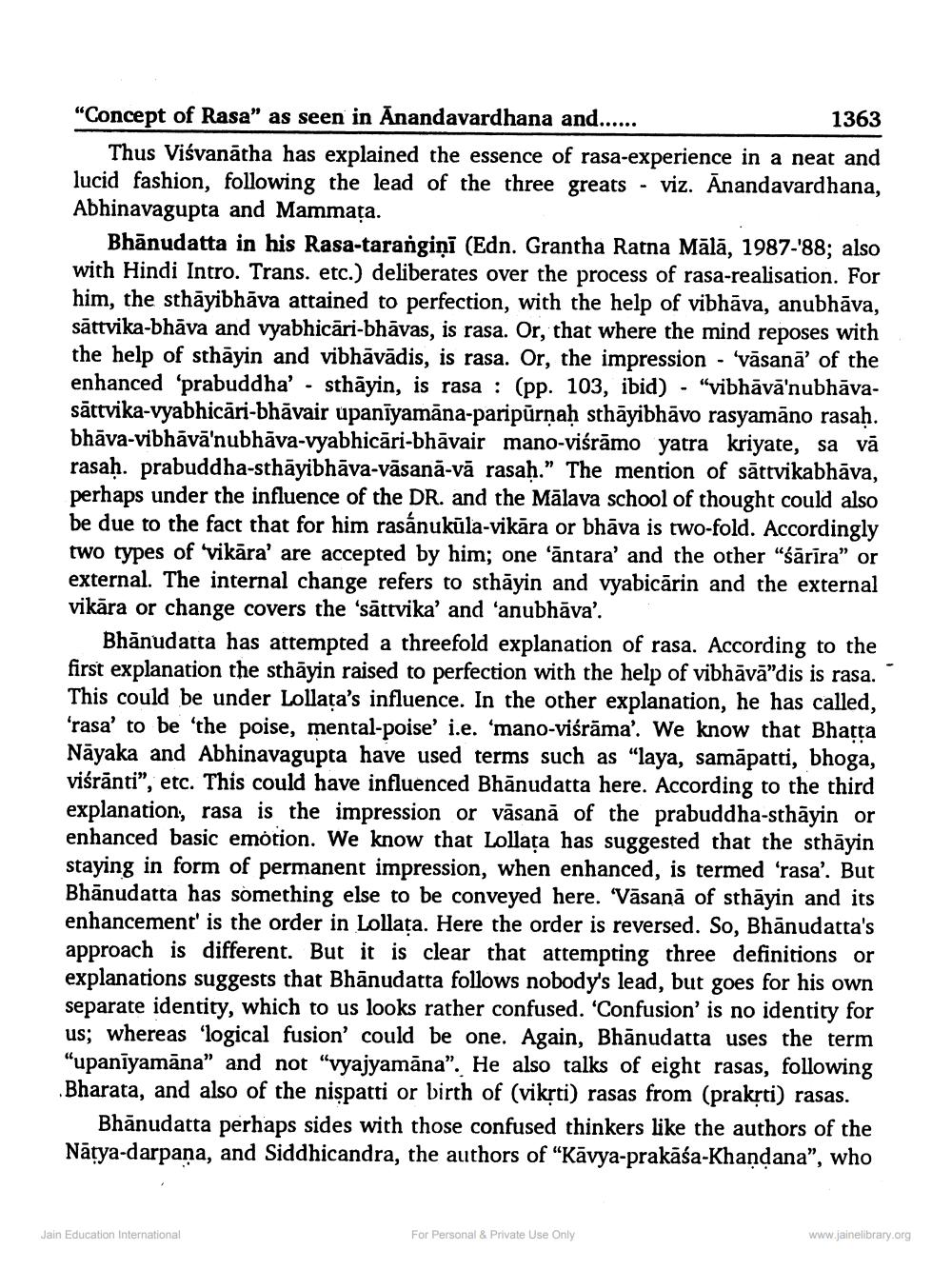________________
"Concept of Rasa” as seen in Anandavardhana and.....
1363 Thus Visvanatha has explained the essence of rasa-experience in a neat and lucid fashion, following the lead of the three greats - viz. Anandavardhana, Abhinavagupta and Mammata.
Bhānudatta in his Rasa-tarangini (Edn. Grantha Ratna Mālā, 1987-'88; also with Hindi Intro. Trans. etc.) deliberates over the process of rasa-realisation. For him, the sthāyibhāva attained to perfection, with the help of vibhāva, anubhāva, sättvika-bhāva and vyabhicări-bhāvas, is rasa. Or, that where the mind reposes with the help of sthāyin and vibhāvādis, is rasa. Or, the impression - vāsanā' of the enhanced 'prabuddha' - sthāyin, is rasa: (pp. 103, ibid) - "vibhāvā'nubhāvasāttvika-vyabhicāri-bhāvair upanīyamāna-paripurnah sthāyibhāvo rasyamāno rasah. bhāva-vibhāvā'nubhāva-vyabhicāri-bhāvair mano-viśrāmo yatra kriyate, sa vā rasah. prabuddha-sthāyibhāva-vāsanā-vā rasaḥ.” The mention of sāttvikabhāva, perhaps under the influence of the DR. and the Mālava school of thought could also be due to the fact that for him rasảnukūla-vikāra or bhāva is two-fold. Accordingly two types of vikāra' are accepted by him; one 'antara' and the other "sarira" or external. The internal change refers to sthāyin and vyabicārin and the external vikāra or change covers the 'sātrvika' and 'anubhāva'.
Bhănudatta has attempted a threefold explanation of rasa. According to the first explanation the sthāyin raised to perfection with the help of vibhāvā”dis is rasa. This could be under Lollata's influence. In the other explanation, he has called, 'rasa' to be 'the poise, mental-poise' i.e. 'mano-viśrāma'. We know that Bhatta Nayaka and Abhinavagupta have used terms such as “laya, samāpatti, bhoga, viśranti”, etc. This could have influenced Bhānudatta here. According to the third explanation, rasa is the impression or vāsanā of the prabuddha-sthāyin or enhanced basic emotion. We know that Lollata has suggested that the sthāyin staying in form of permanent impression, when enhanced, is termed 'rasa'. But Bhānudatta has something else to be conveyed here. 'Vāsanā of sthāyin and its enhancement' is the order in Lollata. Here the order is reversed. So, Bhānudatta's approach is different. But it is clear that attempting three definitions or
tions suggests that Bhānudatta follows nobody's lead, but goes for his own separate identity, which to us looks rather confused. 'Confusion' is no identity for us; whereas 'logical fusion' could be one. Again, Bhānudatta uses the term "upaniyamāna” and not "vyajyamāna”. He also talks of eight rasas, following Bharata, and also of the nispatti or birth of (vikrti) rasas from (prakrti) rasas.
Bhānudatta perhaps sides with those confused thinkers like the authors of the Nārya-darpana, and Siddhicandra, the authors of "Kāvya-prakāśa-Khandana”, who
Jain Education International
For Personal & Private Use Only
www.jainelibrary.org




